When I wrote my post on which hitters could most benefit from the “Dodgers Model” of development, one of the responses I got came from longtime virtual friend, and one of the best follows on Giants Twitter, Darryl Zero (nee FlaGiant), who wrote:

This was, of course, exactly the response I had been dreading. Because while seeking out hitters who make contact and control the strike zone can be done fairly easily with a handy dandy stat line and some basic familiarity, seeking out pitchers who are ideal candidates for development improvements takes us into much murkier realms of pure guesswork. Not for nothing that Baseball America article that started this nonsense more or less avoided describing the kinds of pitchers that the Dodgers have had success with (though a quick look tells me it’s mostly guys with elite fastballs).
My first thought (as I discussed with Melissa Lockard in my last podcast) was to focus in on the type of pitcher the Giants have drafted under Farhan Zaidi. Without being dogmatic, it’s notable to me that the Giants avoided going after some of the draft’s hardest throwers. They focused instead on guys with a strong feel for multiple pitches who showed the makings of a true out pitch among their secondaries.
This would seem to match up well with the current trends to pair hard downward breaking balls with four seam fastballs thrown at the top of the zone. This gets you a maximum separation in eye level to go with the separation in velocity between your pitches and has been a pretty unbeatable combination in MLB the last few years. Houston really pioneered this model, trying to maximize the flatness of four seam angle coming in to the top of the zone, along with maximizing the backspin on those fastballs. That combination is not only tough for hitters to reach, it’s particularly hard to hit for power as getting to fastballs up typically flattens swings (low launch angle) and it’s harder to hit through the bottom of the ball and create loft. Furthermore, looking to catch up to fastballs at the top of the zone leaves hitters more vulnerable to attack at the bottom of the zone with breaking stuff.
So let’s posit something of a pitcher-related version of the “power develops last” blueprint that we sought for hitters. The idea is to find guys who have feel for a full repertoire, can pitch to all quadrants with some command, have a feature breaking ball, and a fastball which would benefit from greater biomechanical efficiency and more intentionality of location, leading to:
a) added velocity
b) better repetition of mechanics (control)
c) greater impact from pitch utilization
d) some combination of the above
tl/dr: find guys who have tremendous spin on their breaking balls, and then use some of what Matt Daniels (the Giants co-ordinator of pitching sciences) calls “hacking the kinetic chain” to improve the fastball.
(As an aside, if you haven’t been watching Matt Daniels’ You Tube channel you really should! His insight into the biomechanics of pitching is tremendous).
So let’s take a look at some pitchers who might qualify. It’s not exactly stepping out on a long limb to suggest that the pitchers the Giants have most recently drafted are ones they feel confident of developing, so let’s start there.
Nick Swiney
The following video, if you haven’t seen it yet, has great content on the entire draft class, but I’m particularly interested in what Scouting Director Michael Holmes had to say about Swiney (starting around 1:15):
Holmes describes Swiney as having a “plus changeup…plus breaking ball, and we think his fastball characteristics will play.” All of which sounds exactly like a more concrete version of what I was trying to describe above.
The eye-popping graphic in the video below shows that plus changeup which could be a real kill pitch (Swiney struck out nearly 13 batters per 9 throughout his college career):
But what does Holmes mean about his fastball having characteristics that will play — possibly beyond what you might imagine when you hear “low 90s fastball.” First, as was pointed out to me by viewers of ESPN’s draft coverage, much was made of the fact that Swiney has a soft landing knee (as you can see below), which takes away from power and drive:


So there may be mechanical adjustments the Giants see that they can make with Swiney to increase his fastball velocity. Beyond that, Swiney is also notable for having an extraordinary 22” vertical movement on his fastball. This is referred to as “Z-break” in Trackman readouts, and not surprisingly it’s an element that, again, Houston has used to identify pitchers they can help. Vertical movement on fastballs makes them highly effective at the top of the zone.
If the Giants pitching development folks can use this knowledge to create a Nick Swiney who brings advanced secondaries and pair them with a more powerful fastball that can be employed at the top of the zone as a bat misser? That’s potentially the equivalent of a top 10 talent in the draft! Hopefully when Michael Holmes’ team asked Kyle Haines’ team what they thought about Swiney, that’s just what Kyle said — “Michael, draft that man and I guarantee you we’ll turn him into a top 10 pick talent within a year!” So let it be written. So let it be done.
Kyle Harrison
Ok. Now let’s start looking at curveballs! De La Salle High School star Kyle Harrison brings it — and guess what? He has a soft knee too! Harrison, who as Holmes notes in the video above, was a workhorse for the Team USA 17U national team, is in a lot of respects something of a younger version of Swiney. As I’ve noted in other places, Trackman’s Zach Day highlighted Harrison’s curve as one of the best offerings in the prep class according to his data readouts. He shows a feel to pitch, can use his repertoire in all quadrants of the strikezone and, like Swiney, shows a fastball that they may be able to work with to increase power and effectiveness. As the bonuses will ultimately tell us, the Giants draft in some ways revolved around getting Harrison into the fold and I’m pretty jazzed he’s here. The Giants may have really picked up some exciting arms in this draft without going after them at the top.

Want to see a right-handed version of Harrison? That would be 2018 pick Trevor McDonald:

No soft knee to fix there, as McDonald already lands on a strong stiff knee. But McDonald had already increased his velocity about 5-6 mph in his senior year in High School and, as we can see above, can really can spin a ball. Design that curve so that it’s more of a true 12 to 6 breaker (true of Harrison too) and then teach him to elevate the fastball? As you recall from my podcast with Matt Collier, FaBIO already identified McDonald as the third best starting pitching prospect in the system (prior to the draft). There’s high potential for development in these two kids.
So moving on from the guys this team has drafted, who else in the system fits into this general development paradigm? Searching the system, the Number 1 guy who comes to my mind is someone else this front office has gone out and acquired:
Kai-Wei Teng
Teng, one of three players acquired from Minnesota in the Sam Dyson deal, brings arguably the most interesting starter portfolio in the system. He legitimately throws four distinct pitches including both a curve and slider. And even within those four he’s shown the ability to use his breaking balls both to steal strikes within the zone…

…and to bury it below the zone and get hitters to chase.
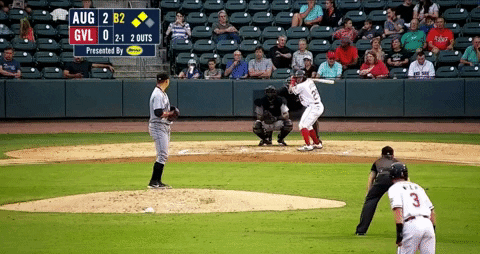
From a traditional scouting POV, the issue with Teng is that the big-bodied 21 year old is “maxed out” physically and doesn’t have projection left on his low 90s fastball, which in today’s game is just fringe average at best. Teng is, in other words, something of a right-handed Swiney with even more pitches at his disposal. And the question will be, does his fastball have, as Holmes said above, “characteristics that will play?” The key with Teng may be more about how he deploys his repertoire than necessarily finding more power in the fastball (though that would certainly help). All three of his secondary pitches can miss bats, so his development might hinge on how and where in the zone he uses his fastball, as well as developments that might help his spin rate (another thing Houston has done successfully) or movement. Teng already shows a feel for sequencing and reading batters’ swings and a high pitching IQ for one so young.
Tristan Beck
Right behind Teng is another trade acquisition for the Giants last summer, former Stanford star Beck. Beck’s calling card has always been his 12-6 curve. But two things changed with Beck once he joined the Giants last summer (whether causation implies correlation or not I’ll leave up to you). His fastball picked up a slight bit more zip from the lackluster, 89-91 area he’d been working at with the Braves after a back injury in college stole his velocity. And very noticeably he started using that pitch — where? — at the top of the zone much more often with the Giants. To the point that in the “Prospect Handbook,” BA noted there were essentially two separate scouting reports for Beck last year: one from guys who saw him with the Braves and one from guys who saw him with the Giants. Clearly this was a process innovation the Giants wanted to see from Beck and we know why: top of the zone fastball, bottom of the zone curve is the power combo they want to see to make his stuff play up (he also features a slider and change that are behind the front two pitches)

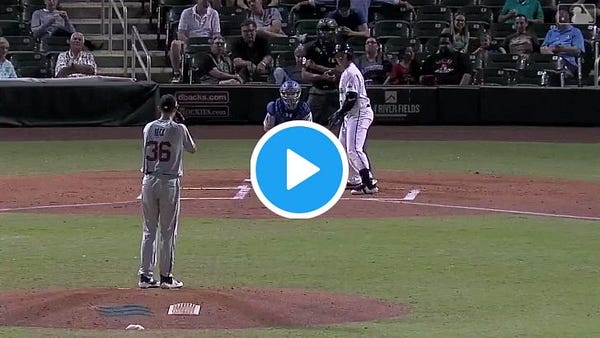
Sean Hjelle
What about the big fella, Sean Hjelle? He too features a sharp, downward breaking ball as his primary kill pitch.
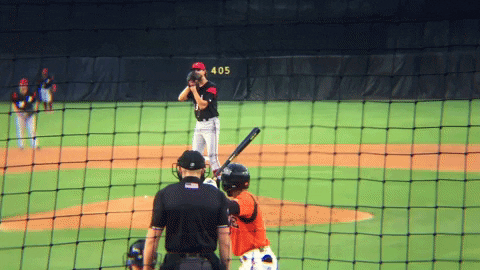

Hjelle already has a motion he repeats well and can throw strikes consistently with all three of his pitches (included his much-improved changeup). Hjelle already brings solid velocity, getting his fastball up to 95 in early innings, though it will fade into the 92-93 area as he gets into the middle innings.
My question with Hjelle is whether he might be able to get more out of his fastball if he works it up at the top of the zone more to tunnel it off of his curve. This is a tricky matter as generally speaking what we’re hearing from data analysts is that fastballs at the top of the zone work best if they’re “flat” while fastballs with a lot of downward plane on them work best at the bottom of the zone. Obviously the 6’11” Hjelle is bringing an exceptional amount of downward plane to his pitches which would suggest that the bottom on the zone is where he should be — and that is where he tends to live with his stuff now. But my looks at Hjelle at AA struck me that batters got awfully comfortable looking for everything down and being able to disrupt their sight-lines from time to time might help. This would be in keeping with Chris Young, for instance, the 6’10” pitcher who built a successful major league career throwing a (by the radar gun) below average fastball up at the top of the zone from a high release point.
Kervin Castro
Castro is the anti-Hjelle. A converted Catcher, the 20-year old Castro stands just 6’0”. That appears to be helping him succeed with exactly the type of “flat” fastball at the top of the zone discussed above. Castro is the type of “hammer and hop” pitcher that Zach Day refers to succeeding with a 12-6 curveball down and a flat fastball that appears to rise (hop) at the top of the zone.
I’ll apologize that the only good breaking ball image I have for Castro is on the loopy side, but at least you’ll get a feel for what his motion looks like:

Now the problem with Castro is that he is bringing just a two-pitch mix which won’t make him a starter long term. But he does show excellent control of both pitches. Working to refine the sharpness of the break on the curve and develop a changeup to attack left-handed hitters will be essential to Castro’s development.
Gregory Santos
And lastly in this group, let’s talk about young Gregory Santos. The 20 year old has really tightened up his control of the strike zone over the years to where he throws strikes pretty consistently with all of his offerings (fastball, slider, change). What’s interesting about Santos is while he brings power stuff, he hasn’t really been missing bats with the consistency you’d expect, particularly with the fastball. I’d think with Santos, the Giants might try to design a new fastball grip to give it more vertical movement (right now its movement is almost entirely horizontal run) and look to use it at the top of the zone more often. Then he can do more of this:

So all of the above guys fit roughly into the description Holmes used for Swiney at the top. And given my description above, these are the guys I would expect the Giants to have the most success developing. But there is another bucket that a lot of the Giants’ pitching depth fits in, and it’s trickier to work with — the “wicked stuff, lousy control” group. I’m not going to go into too much depth with these guys, but they all bring at the very least a nasty breaking ball and power stuff that they have trouble corralling. The challenge here obviously is going to be finding mechanics that can be repeated and controlled. The link above to Matt Daniels’ You Tube videos give us hints of how to go about this, as he talks about the various ways that pitchers lose effectiveness when various parts of their kinetic chain break down.
Blake Rivera
For my money, here is the prettiest spinner in the Giants system today. An honest to god, knee-buckler from the man from Wallace State. This is a true beauty:

No looping there. Look at the sharpness of that bite! That pitch alone gives Rivera a potential path to the majors. But he also throws a very heavy, cutting mid-90s fastball that can reach even higher. Blake’s mission, of course, is to find some consistency with this pitch and start to utilize it to its best advantage. As Melissa Lockard mentioned last week, the key to Rivera’s fastball is really finding mechanics with his arm action that he can repeat. If they can find that — 96 with hop at the top of the zone coming off that hammer? That’s gonna work at the top level.
Though FaBIO disagreed with me, my guess is that Rivera is ultimately a reliever. And he’s not alone among Giants’ relief prospects who have some of the same issues. Most prominent are the group of Jose Marte (who the Giants are still trying to develop as a starter), Camilo Doval, Melvin Adon, and Raffi Vizcaino. All of these guys have the potential to be dominant arms at the back of a bullpen IF they can improve their consistency and command.
Jose Marte

Camilo Doval

Melvin Adon

Raffi Vizcaino
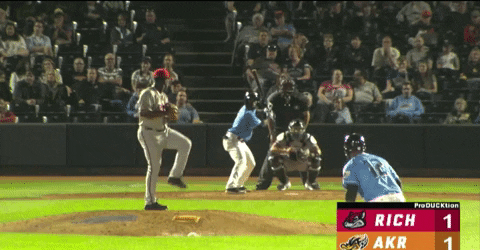
Adon and Doval both bring a very slingy arm action that seems to “lock in” or “lock out” at times. That can lead to long stretches of dominance and other stretches where they seem almost incapable of throwing strikes. Vizcaino pairs an upper 90s fastball (you can see how effective it is at the top of the zone above) with a dastardly hook, but his command is well below average pretty consistently. For all of these guys the stuff is there to be impactful big league pitchers. The key will be getting to a point where they understand — and have control of — their bodies enough to make adjustments when things are falling out of sync. Pitch by pitch adjustment is a hallmark of major league pitchers that often goes unappreciated.
Finally, you’ve probably noted that I haven’t said anything about Seth Corry yet. This isn’t to slight Corry, who is my selection for the best pitching prospect in the system. There’s no real secret here — Corry brings excellent stuff and improving control and simply needs to keep progressing on the path he’s on. No secret ingredient! But I don’t want to slight you the sight of a Seth Corry curve ball, so let’s end on a beaut!

On this Day in History
2007: Emmanuel Burriss had the only five hit day of his professional career, helping Augusta to an 11-7 extra innings victory in Greensboro. The Giants had tried to jump their supplementary 1st round pick from 2006 from Salem-Keizer all the way to San Jose. But after hitting just .165 through May 17, they swapped Burriss with Augusta SS Brian Bocock. The move paid off as Burriss hit .321 the rest of the season. Amazingly, both of their light-hitting 2006 draftees would see time at the SS position in San Francisco the very next season in the Giants desperate attempt to recover from Omar Vizquel’s spring training injury.
2011: Joe Panik continued to swing a hot stick to start his career, hitting his 2nd HR in Salem-Keizer’s 4-3 loss to Eugene. Over his first five games, the Giants’ surprise 1st round pick had gone 11 for 21 with two homers, a double and 3 walks. Panik would keep on hitting, ultimately leading the NWL in average at .341 and finishing second in OBP (to teammate Shawn Payne) at .401. He also posted a minuscule 8% K rate and walked more than he struck out, showing the offensive strengths that would ultimately make him a big league All Star.
2019: Marco Luciano homered for the third consecutive game in the AZL Giants Orange 4-2 loss. It was the end of a spectacular first week of pro ball for the 17 year old phenom. After two hitless games to begin his career, Luciano exploded, going 10 for his next 18 including three homers, two doubles, and a triple. Over the next two months, the young SS would stake his claim to being one of the most exciting prospects in the minor leagues, hitting .322/.438/.616 in the complex league before earning a late year promotion to Salem-Keizer.
We miss you baseball! Come back, please.





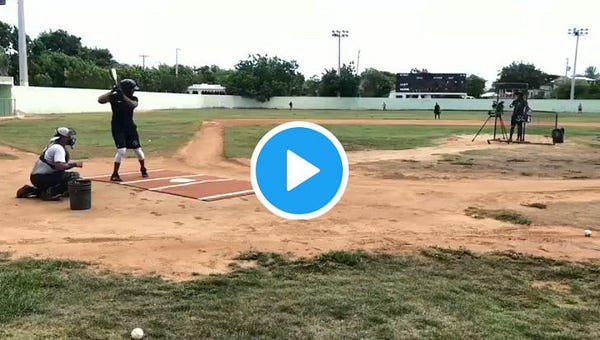
This was really well done, Roger. Great work.